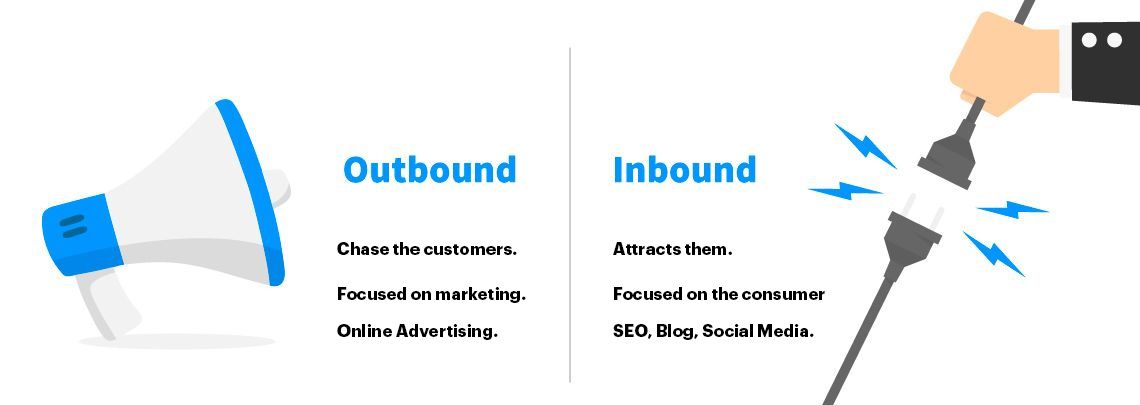Inbound Marketing consists of a series of methods and techniques designed to create content that is attractive to consumers and draws them in naturally. With more and more brands competing for consumers’ attention, audiences are becoming overwhelmed by advertising messages, making them less effective. To address this, brands must innovate their marketing strategies to ensure their messages reach their target audience in a non-intrusive way.
This is where Inbound Marketing comes in as a solution.
But what is it, how does it work, and what benefits does it offer?
What is Inbound Marketing?
The term “Inbound Marketing” was coined in 2005 by Brian Halligan, co-founder and CEO of HubSpot. It gained popularity in 2009 with the publication of the book Inbound Marketing: Get Found Using Google, Social Media, and Blogs, written by Halligan, Dharmesh Shah (another HubSpot co-founder), and David Meerman Scott (a marketing strategist and author).
Inbound Marketing allows users to find you instead of you having to actively seek them out. It is a methodology that combines marketing and advertising techniques in a non-intrusive way to capture consumer attention and make businesses easier to find in the digital world.

It is a strategy that combines different forms of pull marketing—techniques that organically attract consumers to a company without pressuring them, while providing value. It is the opposite of outbound marketing, which mainly relies on marketing and advertising techniques that tend to reach consumers intrusively, delivering unsolicited commercial messages.
How does it work?
The main focus of Inbound Marketing is to reach users by providing value. This is primarily achieved by offering content that educates or entertains users, responds to their needs, and is personalized. Additionally, context is crucial—we must deliver useful content at the right moment.
This strategy revolves around the user, aiming to turn strangers into brand advocates by adapting content and strategy based on where the user is in the buying process.
Attract
At the beginning of this phase, it’s essential to define your buyer persona. A buyer persona is a detailed representation of your target audience, summarized into a believable and coherent personality. This involves answering questions such as:
- How old are they?
- Where do they live?
- How do they consume content and on which platforms?
- What topics interest them?
- Who are their influencers?
- What is their daily routine?
- What challenges do they face in their lives?
With this information, a brief story (a paragraph) is created to define this person, giving them a personality. Having a clear image of your target audience helps shape the strategy and the type of content to offer.
Once the buyer persona is defined, we move to the first phase: Attracting. The goal here is to turn a stranger into a website visitor. However, the aim is not just to generate traffic but to attract high-quality traffic—that is, users who are more likely to become customers.
Some tools used to attract users to your website:
- Blogs: One of the most powerful elements in Inbound Marketing, blogs help drive traffic to your site. The key is to create content that educates or entertains users while remaining relevant to the product or service your company offers.
- Social Media: Social platforms allow brands to showcase their personality and interact with users. Sharing valuable content on social media drives more traffic to your website.
- SEO: Many searches start on Google (or other search engines), making it essential to rank well. Identifying relevant keywords for your business and incorporating them into your website and content helps improve visibility.
Convert
In this phase, the goal is to turn visitors into leads—in other words, implementing strategies to capture visitors’ information and add them to the company’s database.
Key tools to convert visitors into contacts:
- Calls to Action (CTAs): Encourage users to take action, such as downloading valuable content in exchange for filling out a form.
- Landing Pages: These pages are linked to CTAs and are designed specifically to collect user data.
- Forms: To obtain data, forms should be designed to be quick and easy, as users tend to avoid lengthy or complex processes.
Close
At this stage, website visitors are now leads, but the goal is to convert leads into customers. Several tools can help with this:
- CRM (Customer Relationship Management software): A CRM allows businesses to track where leads are in the buying process, helping tailor content to nurture their interest.
- Email Marketing: Sending personalized emails based on a lead’s stage in the buying cycle can significantly increase conversion rates.
- Marketing Automation: This involves two key techniques:
- Lead Scoring: Evaluates the level of interest of a lead and determines if they are a good fit for the business.
- Lead Nurturing: Builds relationships with leads by delivering personalized content throughout the buying journey.
Delight
Inbound Marketing doesn’t just aim to acquire customers—it focuses on retaining them and turning them into brand advocates. In this phase, businesses continue providing valuable information through social media, email, blogs, and other channels. Additionally, leads who haven’t yet converted (perhaps due to budget constraints) are still nurtured, as they could become customers in the future. Satisfied customers and engaged leads can help promote the brand within their networks.
What are the benefits of Inbound Marketing?
- Attracts the target audience organically, avoiding advertising saturation and increasing engagement.
- Reduces customer acquisition costs, as content continues to generate traffic over time, unlike paid ads, which disappear once the budget runs out.
- Provides deeper insights into the audience, allowing for more effective marketing strategies.
- Increases customer loyalty, as non-intrusive engagement fosters trust and a positive brand perception.
- Enhances brand positioning and SEO, making the company more visible on search engines.
Inbound Marketing offers numerous advantages for businesses in today’s digital landscape. While it doesn’t replace Outbound Marketing entirely, it helps reduce dependency on it and minimizes advertising saturation.
